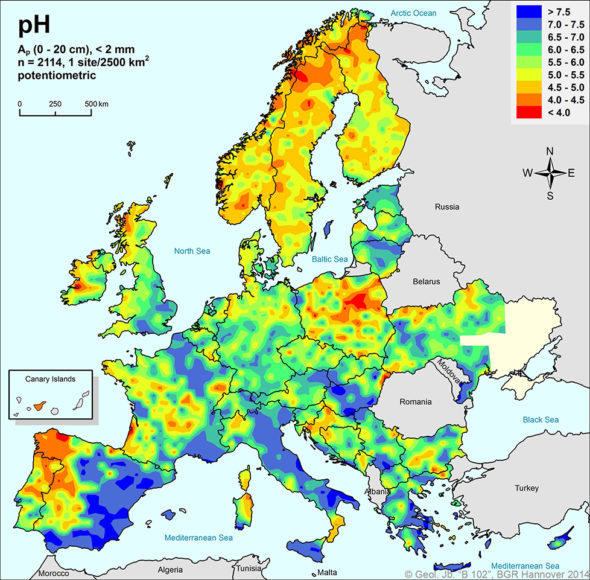A nitrogen or phosphorus balance refers to the difference between nitrogen or phosphorus applied to arable land and nutrients taken up by crops (field nutrient budget). If the nutrient balance is 0, the amount of nutrients applied during the growing season equals the amount taken up by crops. The lower the nutrient balance figure, the less nutrients remain in the field to be exposed to leaching. A negative nutrient balance indicates that the amount of nutrients taken up by crops is higher than the amount applied by fertilisation.
The calculated nutrient balance does not, as such, describe the nutrient loading on water bodies in the short term, but it facilitates assessing its risk.
In Finland, nutrient balances have fallen throughout the country during the thirty-year review period; the main reason for this has been the decline in the use of commercial fertilisers. The nitrogen surplus per hectare has decreased from 90 kilogrammes to 54, and that of phosphorus from 30 to less than 6. Over the last few years, the balance surpluses have not decreased, and the differences between the growing seasons appear as variations in surpluses. The differences in regional averages are mainly due to the focus of livestock and cereal production in different regions.
Nitrogen and phosphorus balance of Finland, kg/ha
As to the nutrient load on water bodies, it is important to determine the minimum nutrient in the receiving water body. In Finland, this is usually phosphorus. Its amount contributes directly to the eutrophication of water bodies. The high phosphorus content of livestock manure causes problems in certain areas, such as Southwest and Western Finland where pig and poultry farming are prominent. A recent nutrient study jointly completed by several research institutes found that at least 20% of the amount of manure produced in Finland requires advanced processing to make the transport of manure phosphorus over long distances outside the region economically feasible. Among other measures, this requires water removal from manure. The need for advanced processing is highest in the regions of Ostrobothnia, Satakunta and Southwest Finland.[1]
Nitrogen balances have decreased drastically throughout Europe over the last 25 years. Two factors explain this: (1) the decrease in the use of nitrogen fertilisers, and (2) the nitrogen binding in standing crop. With increasingly large harvests, more efficient use has been made of nitrogen in arable land.
The nitrogen balance has declined in almost all European countries, and the range in the balance is wide by country. The severity of environmental problems and eutrophication caused by nitrogen depend, inter alia, on the type of soil in each country, the proximity of water bodies and the volume of the receiving water masses. The nitrogen balances of different countries must therefore be associated with these factors. For example, small island states such as Cyprus and Malta, surrounded by the deep Mediterranean Sea, have the highest nitrogen balances in Europe, followed by the Benelux countries – Belgium, the Netherlands and Luxembourg. Their nitrogen balances are 3–4 times higher than Finland’s. Finland ranks average in comparisons of European countries’ nitrogen balances.
Nitrogen balance in OECD countries, 2016
Source: OECD, Agri-environmental indicators database Note: 2013 figures for Germany, Switzerland, Ireland, Sweden and Romania.
High nitrogen balances increase the risk of high nitrate levels in groundwater, where they are a key indicator to be monitored. High nitrate content of household water poses a danger to health. Nitrate levels in surface and groundwaters in Finland are low compared to other European countries (Water quality and use).
In Europe, the acidity of agricultural land varies greatly between regions. In Finland, all soil is relatively acidic, with a pH of 5–6.
Acidity of agricultural land in Europe
 Source: Data DVD Reimann, C., Birke, M., Demetriades, A., Filzmoser, P. & O’Connor, P. (eds.) “Chemistry of Europe’s Agricultural Soils. Part A”; Geol. Jb., B 102; © 2014, BGR, Hannover, Germany.
Source: Data DVD Reimann, C., Birke, M., Demetriades, A., Filzmoser, P. & O’Connor, P. (eds.) “Chemistry of Europe’s Agricultural Soils. Part A”; Geol. Jb., B 102; © 2014, BGR, Hannover, Germany.
Acidic soils require more phosphorus for the production of high crop yields than neutral or alkaline land. Elsewhere in Europe, where the soil is neutral or alkaline, cultivated plants tend to need less phosphorus. In these areas, the result is a better phosphorus balance, which can, at its lowest, even be negative.
Phosphorus balance in OECD countries, 2016
Source: OECD, Agri-environmental indicators database Note: 2013 figures for Germany, Switzerland, Ireland, Sweden and Romania.
Database tables
Nitrogen and phosphorus balances (kg/ha) in Finland by provinces (ELY-centre areas)
Nitrogen balances if OECD countries
Phosporus balances of OECD countries
References
[1] Marttinen, S., Venelampi, O., Iho, A., Koikkalainen, K., Lehtonen, E., Luostarinen, S., Rasa, K., Sarvi, M., Tampio, E., Turtola, E., Ylivainio, K., Grönroos, J., Kauppila, J., Koskiaho, J., Valve, H., Laine-Ylijoki, J., Lantto, R., Oasmaa, A., zu Castell-Rüdenhausen, Malin. (2017) Kohti ravinteiden kierrätyksen läpimurtoa: Nykytila ja suositukset ohjauskeinojen kehittämiseksi Suomessa, Luonnonvarakeskus, 45/2017, 45 p. Link to report
[2] Natural Resources Institute Finland (Luke) Statistics – Nitrate content in surface water and groundwater
Photo in upper edge: Pixabay
